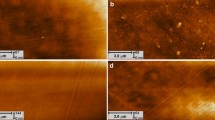Abstract
Porcine fibrinogen was extracted from blood and dissolved at different concentrations in two types of solvents. Both types had the same ionic strength but differed in pH and osmolarity, and thus had different fibrinogen solubilities. Each type of fibrinogen solution was divided and used to expose two tubes of silicone rubber. One tube of each pair was primed normally, and the other was subjected to our procedure for removing the air nuclei from the surface roughness during the priming procedure. It was found, depending on fibrinogen concentration, pH, and osmolarity of the solvent, that the adsorption to normally primed silicone rubber was as much as 50% greater than on the denucleated material. At conditions corresponding to physiological, the adsorption was approximately 8% greater on normally primed material. If the surface concentration is greater than approximately 0.4 μg/cm2, there is evidence from the isotherm of lateral of multi-layer interaction which may be an indication of denaturing of adsorbed fibrinogen. The increase in adsorption due to the air nuclei indicates that the level of adsorption at each air nucleus on the surface is much above that at which interactions take place between the adsorbed molecules.
Similar content being viewed by others
References
Aveyard, R. and D.A. Haydon.An Introduction to the Principles of Surface Chemistry. Cambridge: Cambridge University Press, 1973, p. 218.
Bell, G.H., J.N. Davidson, and H. Scarborough.Textbook of Physiology and Biochemistry. Edinburgh and London: E. and S. Livingstone Ltd., 1961.
Blombäck, B. and M. Blombäck. Purification of human and bovine fibrinogen.Ark. för Kemi. 10:415–443, 1957.
Brash J.L. and D.J. Lyman. Adsorption of proteins and lipids to nonbiological surfaces.In:the Chemistry of Biosurfaces, edited by M.L. Hair, New York: Marcel Dekker, Inc., 1971, vol. 1, pp. 177–232.
Brunauer, S., L.S. Deming, W.E. Deming, and E. Teller. On a theory of van der Waals adsorption of gases.J. Am. Chem. Soc. 62: 1723–1732, 1940.
Brunauer, S., P.H. Emmett, and E. Teller. Adsorption of gases in multimolecular layers.J. Am. Chem. Soc., 60: 309–319, 1938.
Cheesman, D.F. and J.T. Davies. Physiochemical and biological aspects of proteins at interfaces.Ad. Protein Chem., 9: 439–501, 1954.
Chuang, H.Y.K., W.F. King, and R.G. Mason. Interaction of plasma proteins with artifical surfaces: Protein adsorption isotherms.J. Lab. Clin. Med., 92: 483–496, 1978.
Cohn, E.J., L.E. Strong, W.L. Hughes, Jr., D.J. Mulford, J.N. Ashworth, M. Melin, and H.J. Taylor. Preparation and properties of serum and plasma proteins. A system for the separation into fractions of the protein and lipoprotein components of biological tissues and fluids.J. Am. Chem. Soc., 68: 459–475, 1946.
Fountain, S.W., J. Duffin, C.A. Ward, H. Osada, B.A. Martin, and J.D. Cooper. Biocompatibility of standard and silica-free silicone rubber membrane oxygenators.Am. J. Physiol.: Heart and Circulatory Physiology. 5: H371-H375, 1979.
Fountain, S.W., J. Duffin, C.A. Ward, B.A. Martin, and J.D. Cooper. Combination of sulfinpyrazone pretreatment with denucleation priming for membrane oxygenator perfusion of sheep.A.S.A.I.O. J., 2: 86–91, 1979.
Koral, J., R. Ullman, and F.R. Eirich. The adsorption of polyvinyl acetate.J. Phys. Chem., 62: 541–550, 1958.
Krohn, K.A. and M.J. Welch. Studies of radioiodinated fibrinogen. Lactoperoxidase Iodination of fibrinogen and model compounds.Int. J. Appl. Radiat. Isot., 25: 315–323, 1974.
Laki, K. The Polymerization of Proteins: The action of thrombin on fibrinogen.Arch. Biochem. Biophys., 32: 317–324, 1951.
Lee, R.G., C. Adamson, and S.W. Kim. Competitive adsorption of plasma proteins onto polymer surfaces.Thromb. Res., 4: 485–490, 1974.
Marchalonis, J.J.. An enzymic method for the trace iodination of immunoglobulins and other proteins.Biochem. J., 113: 229–305, 1969.
Morrissey, B.W. and R.R. Stromberg. The conformation of adsorbed blood proteins by infrared bound fraction measurements.J. Colloid Interface Sci., 46: 152–164, 1974.
Osada, H., C.A. Ward, J. Duffin, J.M. Nelems, and J.D. Cooper. Microbubble elimination during priming improves biocompatibility of membrane oxygenators.Am. J. Physiol: Heart and Circulatory Physiology. 3: H646-H652, 1978.
Packham, M.A., G. Evans, M.F. Glynn, and J.F. Mustard. The effect of plasma proteins on the interaction of platelests with glass surfaces.J. Lab. Clin. Med., 73: 686–697, 1969.
Serrallach, E.N., V.E. Hofmann, M. Zulauf, T. Binkert, R. Hofmann, W. Känzig, P.W. Straub, and R. Schwyzer. Fibrinogen: Agreement of experimental and calculated hydrodynamic data with electron-microscopic models.Thromb. Haemost. 41: 648–654, 1979.
Ward, C.A. and T.W. Forest. On the relation between platelet adhesion and the roughness of a synthetic biomaterial.Ann. Biomed. Eng., 4: 184–207, 1976.
Ward, C.A., B. Ruegsegger, D. Stanga, and W. Zingg. Reduction in platelet adhesion to biomaterials by removal of gas nuclei.Trans. Soc. Artif. Intern. Organs. 20: 77–84, 1974.
Ward, C.A., B. Ruegsegger, D. Stanga, W. Zingg, and M.A. Herbert. Relation of proteins, platelets, and gas nuclei in adhesion to a synthetic material.Am. J. Physiol.: Heart and Circulatory Physiology. 2: H100-H105, 1977.
Zucker, M.B. and L. Vroman. Platelet adhesion induced by fibrinogen adsorbed onto glass.Proc. Soc. Exp. Biol. Med., 131: 318–320, 1969.
Author information
Authors and Affiliations
Additional information
This work was supported by the Ontario Heart Foundation and the Medical Research Council of Canada. The authors thank Drs. Wood and Moscarello of the Hospital for Sick Children for their assistance with the radioiodination technique. The sedimentation tests on the fibrinogen solutions were done by the Ultracentrifuge Facility, Faculty of Medicine, University of Toronto.
Rights and permissions
About this article
Cite this article
Ward, C.A., Stanga, D., Zdasiuk, B.J. et al. Effect of air nuclei on the adsorption of fibrinogen to silicone rubber. Ann Biomed Eng 7, 451–469 (1979). https://doi.org/10.1007/BF02364221
Issue Date:
DOI: https://doi.org/10.1007/BF02364221




